A project timesheet template can help you track, record, and organize essential information related to the project and generate accurate billables.
You can capture data regarding the project timeline on a daily, weekly, biweekly, or monthly basis and analyze it to understand how the project is progressing.
In this article, we’ll share four free, downloadable project timesheet templates (in PDF, Google Sheets, Microsoft Word, and Excel format). We’ll also discuss the benefits and disadvantages of using a manual project timesheet, along with an advanced alternative.
This article includes:
(Click on the link to go to a particular section)
- 4 Useful Project Timesheet Template Samples
- What is a Project Timesheet Template?
- 2 Key Benefits of Project Timesheets
- 3 Major Disadvantages of Project Timesheets
- 3 Handy Tips for Using Project Timesheets
- Time Doctor: An Advanced Alternative to Manual Project Timesheets
Let’s get started.
4 useful project timesheet template samples
A project timesheet template records the time an employee invests on multiple projects and tasks. You can bill your clients conveniently using this timesheet data.
Some employers like to visualize timesheet data to better understand the patterns in hours worked, they typically create a timeline graph in excel with the data in these templates we’ll share with you.
Here are four free timesheet templates suitable for various business requirements. You can access them in Microsoft Word, PDF, Google Sheets, and Excel timesheet template formats.
1. Daily project timesheet template
A daily timesheet template records employee work hours data, including total hours worked in a day and the projects they worked on. This simple timesheet template helps you track billable hours separately for each project.
Additionally, you can view and compare the productivity of employees from this daily timesheet template.
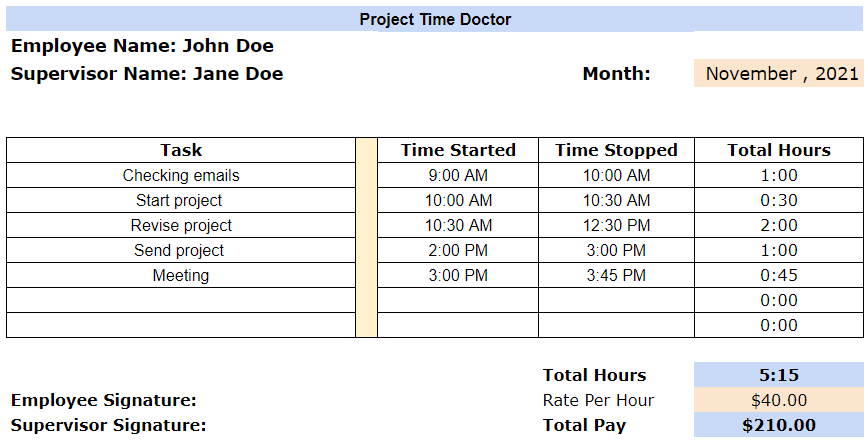
Download timesheet links: Google Sheets | Excel | Word | PDF
2. Weekly project timesheet template
A weekly timesheet template shows you the tasks and projects employees spend their time on during each day of the week. This weekly time tracking template lets you view the total hours worked, lunch break, overtime, sick leave, etc., of an employee.
The weekly timesheet template is suitable for companies with a weekly pay policy.
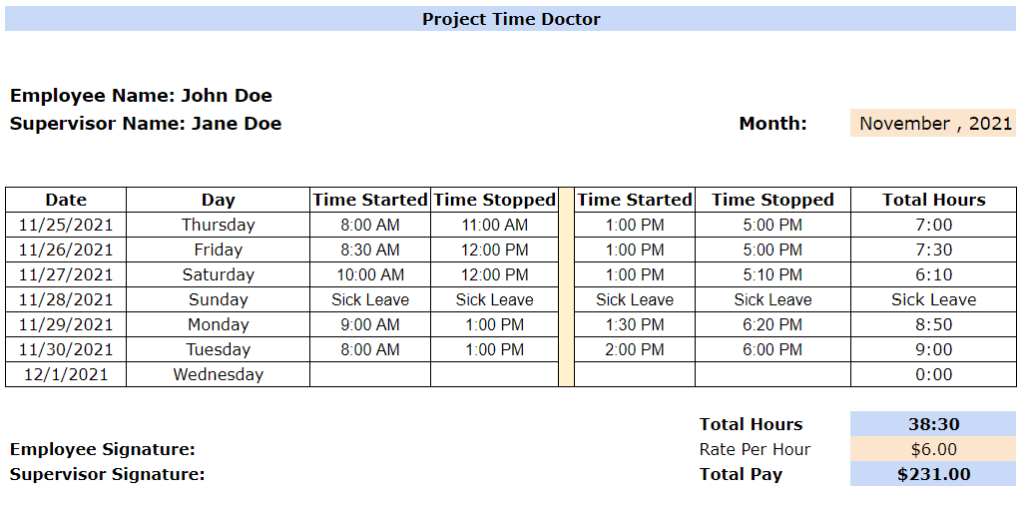
Download timesheet links: Google Sheets | Excel | Word | PDF
3. Biweekly project timesheet template
The biweekly timesheet template tracks employee work hours and tasks completed during two weeks. You can use this biweekly timesheet template to generate payroll twice a month.
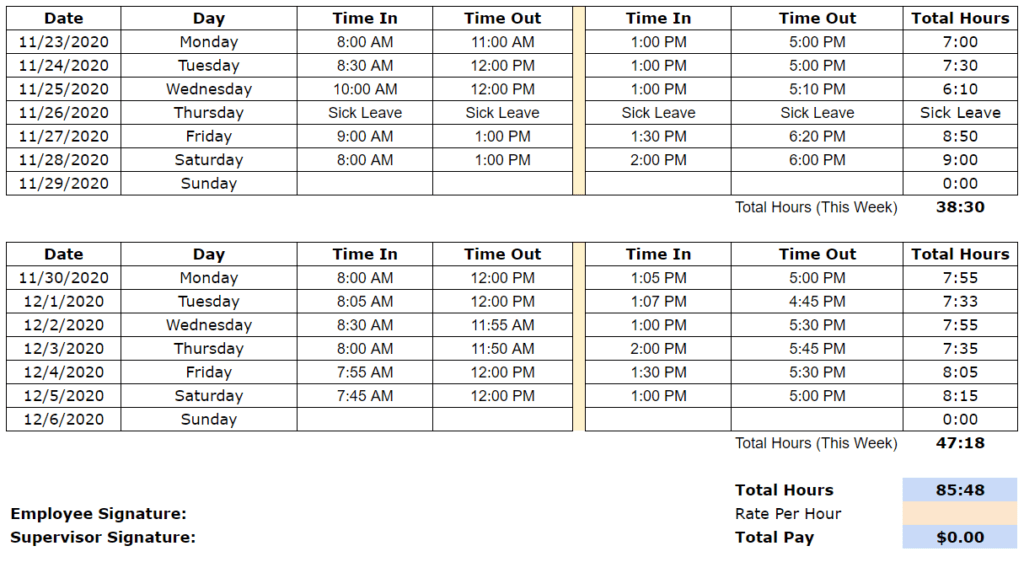
Download timesheet links: Google Sheet | Excel | Word | PDF
4. Monthly project timesheet template
The monthly timesheet template enables you to track employee work hours and projects completed for each day across a month. It also breaks down employees’ monthly working hours to give you productivity insights.
A monthly timesheet template also simplifies payroll processing by easily providing relevant information, like time entries, overtime hours, vacation days, etc.
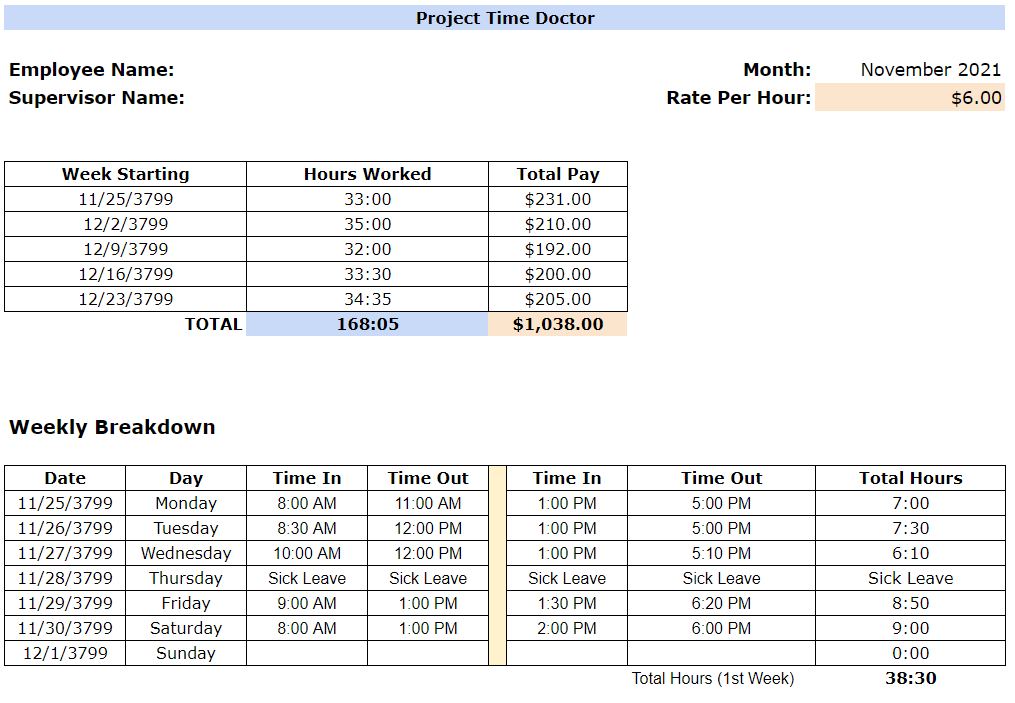
Download timesheet links: Google Sheets | Excel | Word | PDF
These are a few project timesheet templates that you can choose from.
Now, let’s take a step back and discuss the basics of a project timesheet template.
What is a project timesheet template?
A project timesheet template helps track the projects your employees work on, along with the time they take to complete them. You can carry out project tracking for any pay period and for multiple clients using a timesheet.
Employees fill in relevant information manually on a timesheet template. However, collecting and organizing timesheets is tedious, especially since they’ll grow in number and pile up over time.
Today, you can use tools like Microsoft Excel, Google Sheets, etc. In addition to recording time entries and project status, these tools can automate calculations. This way, these tools can make timesheet management a little easier.
Now, let’s look at the pros of using a project timesheet.
2 key benefits of project timesheets
Here are a few benefits of using project timesheets:
1. Simplify project management
A project timesheet can help you record the status of project completion. With this information, you can estimate the progress of a project.
Comparing the project progress against the deadline will give you insights into how close you’re to completing it. You can then take the right steps to speed up the work if needed.
Additionally, based on the timesheet data, you can determine if a specific task is taking too long to complete and assign more employees to tackle it. By doing so, you can ensure strategic employee scheduling and that you meet deadlines on time.
2. Optimize project budget and payroll management
A project timesheet can record billable hours for multiple projects separately. Using this data, you can calculate employee salaries easily.
Additionally, you can track regular hours and tasks on a daily, weekly, or monthly basis. Through this, you can calculate the payment for non-salaried employees.
All you need to do is multiply the total hours worked on specific tasks (obtained from the timesheet) with their hourly rate.
For salaried employees, a project timesheet can help you:
- Ensure project profitability by comparing labor cost and work done.
- Record employee breaks and overtime hours.
- Monitor paid time off, like sick leave, and unpaid time off.
Now, let’s look at the limitations of manual project timesheets.
3 major disadvantages of project timesheets
While a project timesheet has several benefits, it also has disadvantages.
Here are some of them:
1. Prone to time entry errors
Manual spreadsheets are prone to errors. An employee could feed the wrong time entries, copy and paste errors, overwrite unknowingly — the list goes on.
Additionally, since Excel or other spreadsheets don’t allow managers to validate employee data, it’s difficult to spot any error. And even a small error in the timecard can lead to payroll issues.
For example, let’s say an employee incorrectly entered the work hour as 8 AM instead of 10 AM on the Excel spreadsheet. During payroll calculation, this minor error could cause variations in the payment depending on the hourly rate.
Additionally, errors can negatively affect the trust clients have in your business. They may doubt the legitimacy of all the data you submit.
2. Time-consuming task
We can all agree that manually entering data can take up a lot of time.
With a manual project timesheet, your employees need to fill time entries every day, and the manager may have to double-check the data to reduce errors.
Additionally, timesheet management is an exhausting process, especially in a growing company. It’s difficult to store, maintain, and track spreadsheets.
The employee in charge will have to collect and store timesheets and run payroll and other required calculations.
3. Lacks advanced productivity features
Paper timesheets help only with recording employee time in and time out.
And while Excel, Microsoft Word, and Google Sheets can help you carry out simple calculations, organize data, and offer printable timesheet templates.
Also, they may not give you accurate insights into employee productivity. A timesheet only shows the total hours worked and not what employees did during the recorded hours.
Fortunately, you can reduce the effect of these cons by using timesheets properly. Let’s see how you can do that.
3 handy tips for using a project timesheet template
Here are a few tips to help you fill out a timesheet template correctly:
1. Determine which project timesheet template to use
Choose the most suitable employee timesheet template for your business requirements. You can make a decision based on the preferred pay period, information required, and other factors.
For instance, let’s say you want to view daily time entries and total weekly employee hours worked. You can then use a weekly timesheet template that gives insights into an employee’s working hour data.
Depending on the features you need, you can also choose between a Microsoft Word, Google Sheets, and Excel template.
2. Remind employees to track time
Team members may forget to note the start and end times if they don’t note it down. You can ask them to fill the timecard before they start and as soon as they complete the project task.
3. Assign project codes
While assigning project codes may not seem necessary, it can avoid confusion and simplify tracking projects.
How?
Different employees working on the same project may use different names while filling timesheets. This could complicate tracking project progress and resource allocation and cause confusion.
For example, an employee writing a blog post on ‘Flexible Hybrid Work’ can log time as ‘Flexible Hybrid Work’, while another can save it as ‘FHW’.
By assigning project codes, you can identify the project immediately and save a lot of time.
However, these tips can only help you to an extent since the timesheet process involves manual data entry and analysis.
That’s why you need a smart time tracking software solution that can automate project timesheet management for you. You need Time Doctor.
Time Doctor: An advanced alternative to manual project timesheets
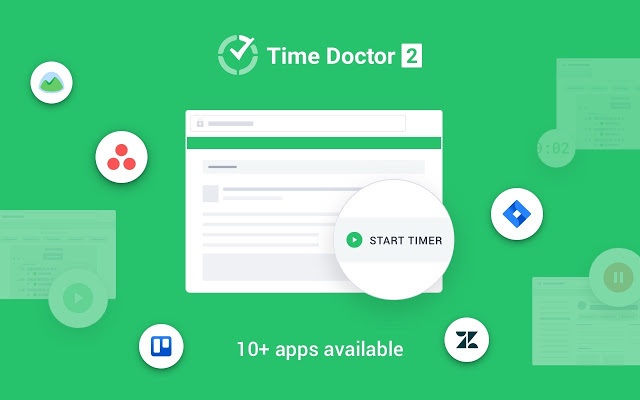
Time Doctor is an employee productivity and time tracking tool that’s used by large businesses, like Ericsson and Verizon, as well as by small businesses, like Thrive Market, to boost employee productivity.
It records time entries of multiple employees simultaneously and tracks how long they work in real-time.
Time Doctor also offers features like productivity reports, payroll management, 50+ tool integrations, and more.
Let’s look into Time Doctor in detail and discuss its key features.
1. Interactive and silent time tracking
Time Doctor’s manual or interactive time tracking feature lets employees record their start and end times by simply clicking on the ‘Start’ and ‘Stop’ buttons of the timer.
You can avoid manual errors as the timer accurately registers the time entries, total hours worked, and other data.
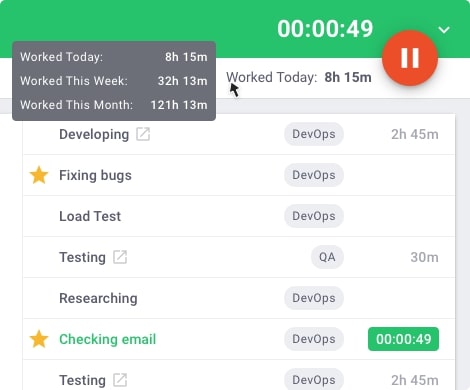
The tool also has an automatic timer, which automatically starts and stops tracking employee hours when the system switches on and off. It runs in the background without interrupting the employee while they work.
2. Project and task management
Time Doctor lets you track the time an employee spends on projects and tasks separately. Your employees can create tasks, add them to a corresponding project, and start tracking time.
Additionally, Time Doctor lets you assign tasks to employees or specific groups.
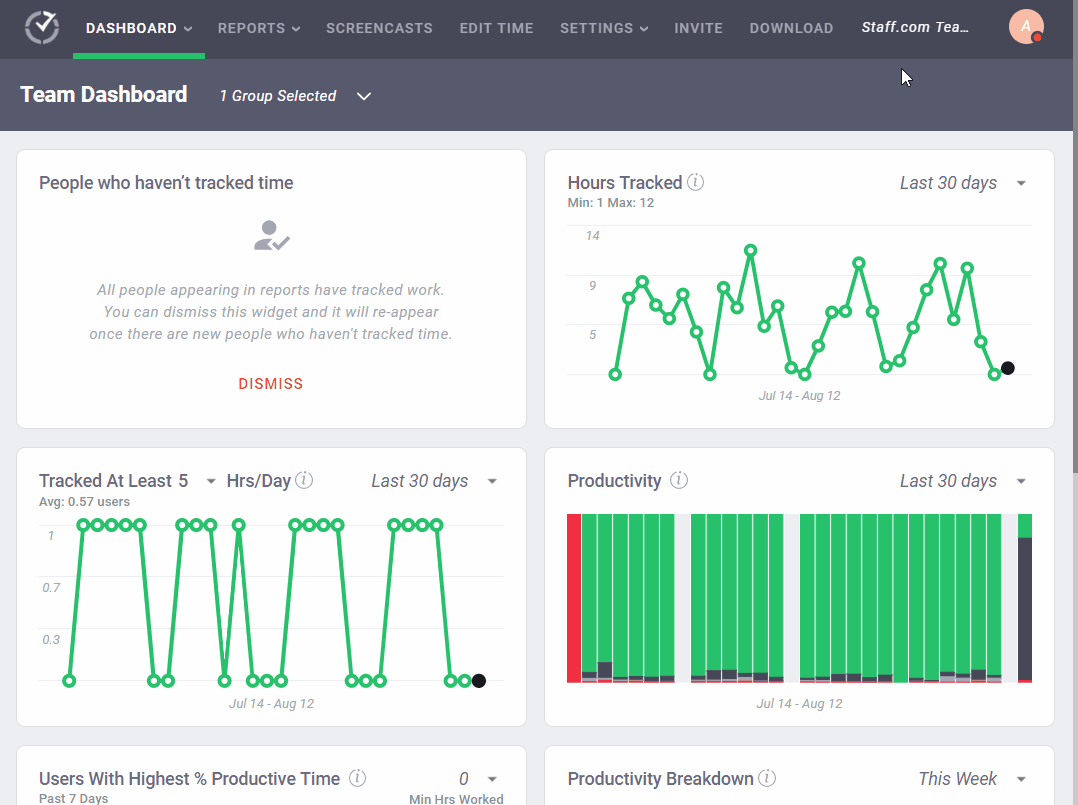
3. Payroll management
Time Doctor has a payroll management feature that lets you easily generate payroll for all employees in just a few clicks. You don’t have to make any calculations to generate payroll, unlike with a traditional employee timesheet.
Additionally, you can customize your payroll by setting the hourly rate and payment currency for each employee.
You can also export your payroll in the CSV format by uploading it to Paypal, Gusto, Wise, or ADP.
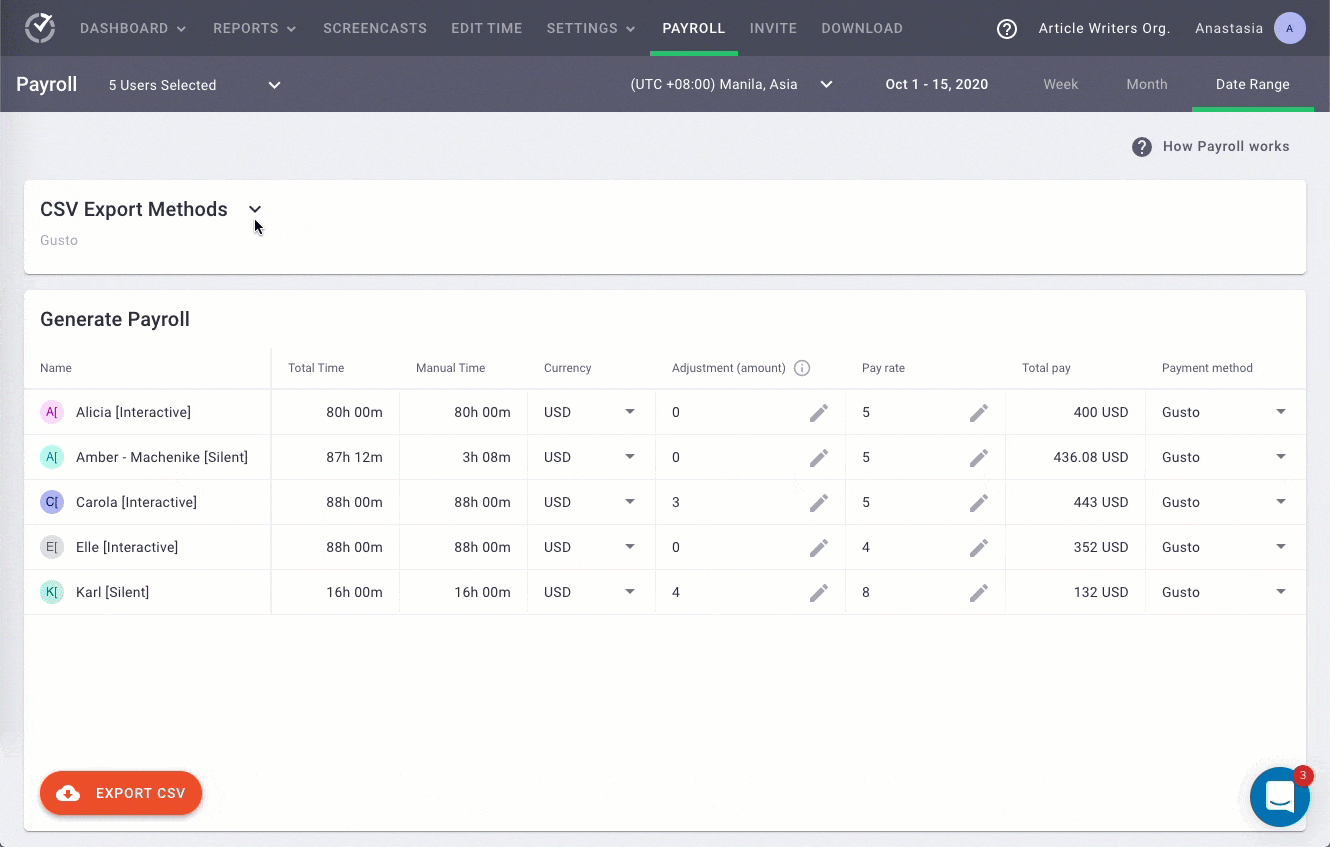
4. Screencasts (optional feature)
Time Doctor lets you take screencasts of employee screens at regular intervals to record what they’re working on in the project. You can set 5, 10, or 30-minute intervals to take screencasts.
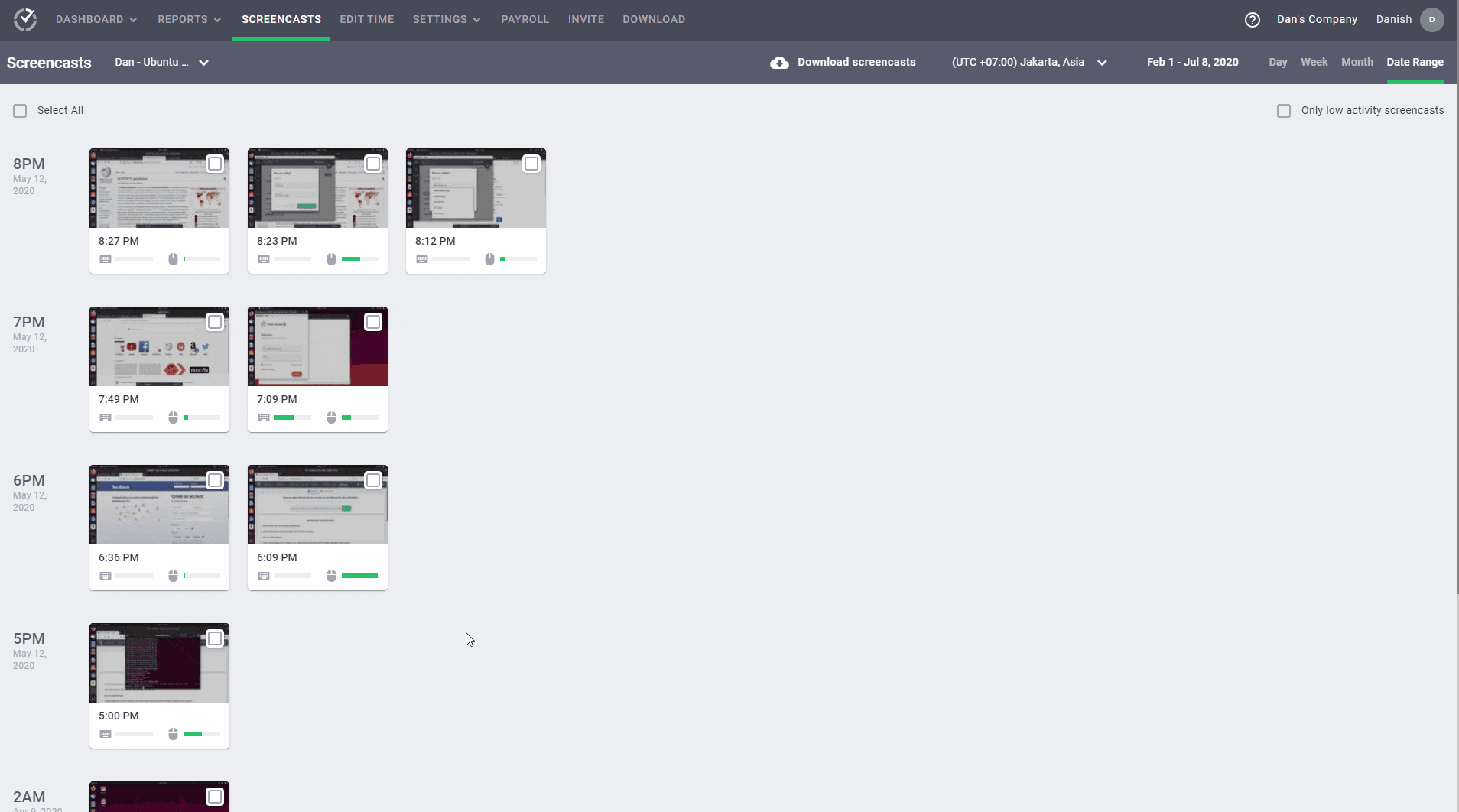
Note: You can blur or delete screenshots to protect the user’s privacy.
5. Productivity reports
A traditional employee timesheet doesn’t have the functionality to generate any report automatically. And manually analyzing and creating a report can be time-consuming and error-prone.
Instead, you can access several productivity reports on project-related matters, productivity, etc., using this timesheet software. Let’s look at some of them:
- Project report: Track the total time spent on the project. List out employees involved in a project and their work hours.
- Timesheet report: Get access to an online timesheet with the total time worked in a day for all employees across a date range.
- Time use report: View the breakdown of an employee’s time spent on a task and associated project during a selected time period.
- Timeline report: Track the detailed breakdown of a day for different employees.
- Web and app usage report: View the websites and applications an employee uses while at work.
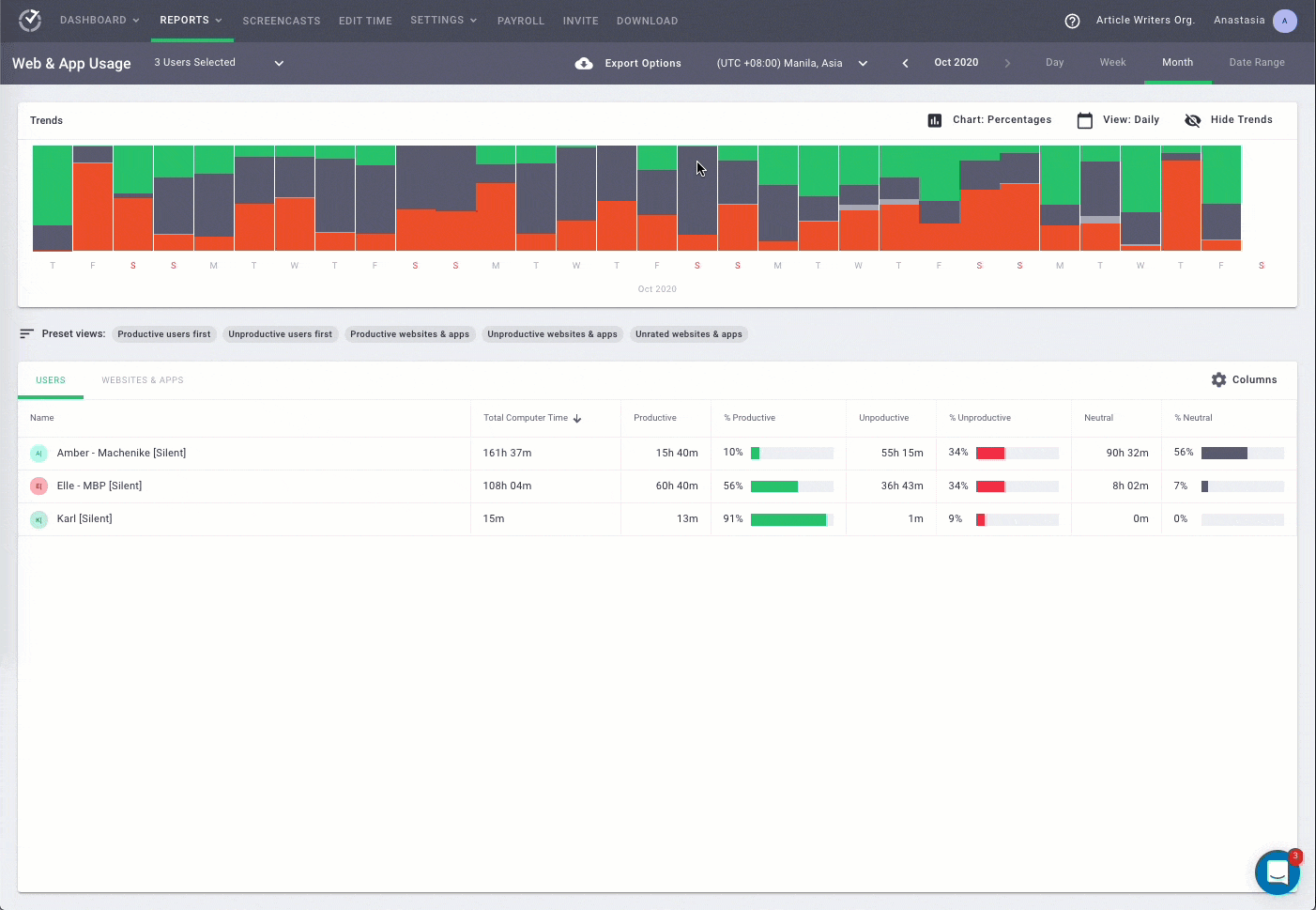
6. Chrome extension
Time Doctor has a powerful Chrome extension that integrates with 50+ tools, enabling smooth project management, employee scheduling, and other business-related activities.
Here are a few of its integrations:
- Project management software: Evernote, Zoho Projects, Asana, etc.
- CRM software: Zoho, Pipedrive, etc.
- Help Desk software: Zendesk, Freshdesk, etc.
Wrapping up
A spreadsheet-based project timesheet template can help you track employee hours and monitor project expenses. You can download the free Microsoft Word, Google Sheets, PDF, and Excel timesheet templates we covered here and customize them for your needs.
However, manual timesheets have several limitations.
Instead, you can use a productivity management tool like Time Doctor for efficient timesheet management. With advanced features like automatic time tracking, smart payroll generation, and productivity reports, Time Doctor makes project time management a cakewalk.
Sign up for Time Doctor’s 14-day free trial today and track everything project-related accurately!

Carlo Borja is the Content Marketing Manager of Time Doctor, a workforce analytics software for distributed teams. He is a remote work advocate, a father and an avid coffee drinker.


